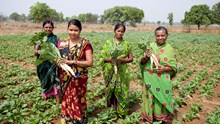
Katarni Rice is a prized, short-grain variety known for its exceptional aroma, delicate texture, and distinctive taste. Grown for generations in the fertile agro-climatic zones of Bihar—particularly in Munger, Banka, and South Bhagalpur—this heritage rice thrives in the region’s unique soil and weather conditions. Revered for its cultural and culinary significance, Katarni Rice is not just a crop but a symbol of Bihar’s agricultural legacy. With high demand in premium markets and recognition through a Geographical Indication (GI) tag, Katarni Rice offers farmers an opportunity to preserve tradition while tapping into profitable, sustainable farming.
Comprehensive Guide to Katarni Rice Cultivation
Climate and Soil Requirements
Katarni rice thrives in a warm and humid climate, with ideal temperatures ranging between 25-35°C. This rice variety requires moderate to high rainfall, typically between 1000-1500 mm annually, along with humidity levels of 60-80% for optimal growth. It grows best in loamy and clayey soils that offer good moisture retention. The soil pH should ideally range from 6.0 to 7.5, and well-drained fields are essential to prevent waterlogging.
Land Preparation
For land preparation, deep ploughing (2-3 times) is necessary to break compact soil layers. Harrowing and leveling ensure a uniform seedbed, and the application of organic amendments like farmyard manure (FYM) or compost improves soil fertility. While bed and furrow preparation are not mandatory for traditional cultivation, modern methods may incorporate them.
Sowing/Planting
-
Time of Sowing: Best sown in June-July (Kharif season).
-
Method: Transplanting is preferred over direct seeding for better yield.
-
Spacing & Depth: 20 cm x 15 cm spacing with 2-3 cm depth.
-
Seed Rate: 30-35 kg per hectare.
-
Seed Treatment: Soaking seeds in fungicide or biofertilizer enhances germination and disease resistance.
Irrigation
Irrigation plays a vital role in the cultivation of Katarni rice. Adequate water is required during different growth stages, particularly during tillering and flowering. In dry conditions, flood irrigation is recommended every 7-10 days. While traditional flooding is commonly used, drip irrigation can improve water use efficiency.
Nutrient Management
-
Fertilizer Recommendations:
-
Nitrogen (N): 80-100 kg/ha
-
Phosphorus (P): 40-50 kg/ha
-
Potassium (K): 30-40 kg/ha
-
Organic Manure: 5-10 tons of FYM per hectare improves soil health.
-
Micronutrients: Zinc and iron supplementation enhances grain quality.
Weed Management
Weed management is necessary to protect the crop from competition. Common weeds in Katarni rice cultivation include Echinochloa spp., Cyperus spp., and Fimbristylis spp. Manual weeding is typically done at 20-30 days after transplanting, and herbicide applications are used for pre-emergence (e.g., Butachlor) and post-emergence (e.g., Bispyribac-sodium) control.
Pest & Disease Management
Pests and diseases also affect Katarni rice. Major pests include the stem borer, which causes dead heart symptoms, and the brown planthopper (BPH), leading to hopper burn. Common diseases include blast disease, which manifests as leaf spots, and bacterial blight, which causes wilting. Integrated pest management (IPM) using biological control agents is the preferred approach, with chemical sprays like Carbendazim for blast disease and Streptomycin for bacterial blight as effective treatments.
Harvesting
-
Maturity Signs: Grains turn golden yellow, moisture content 20-22%.
-
Harvesting Method: Manual harvesting followed by threshing and winnowing.
-
Yield Expectations: 2.5-3.0 tons per hectare.
Post-Harvest Handling
-
Cleaning & Grading: Removes impurities and ensures uniform grain size.
-
Drying: Sun-drying for 2-3 days to reduce moisture to 12-14%.
-
Storage: Stored in airtight containers to retain aroma.
-
Packaging & Marketing: Vacuum-sealed packaging enhances shelf life and export potential.
Yield of Katarni Rice
Katarni Rice has a relatively low yield compared to hybrid rice varieties, but it is highly valued for its premium quality and aromatic properties. The average yield of Katarni Rice is approximately 1 to 1.5 tons per hectare
Economic and Cultural Significance
-
Cost of Cultivation: Estimated at Rs 40,000-50,000 per hectare.
-
Profitability: High market demand due to GI tag recognition and premium pricing.
Katarni Rice is deeply embedded in Bihar’s cultural fabric. It is widely used in religious ceremonies, festive occasions, and traditional dishes such as Chura (beaten rice). Despite its cultural importance, the economic viability of Katarni Rice faces challenges due to low yields, irrigation issues, and market adulteration. Farmers often struggle with production constraints, including poor soil conditions, pest infestations, and lack of improved seeds.
GI Tag Recognition
To protect the authenticity of Katarni Rice and ensure fair pricing for farmers, efforts were made to secure a Geographical Indication (GI) tag, which was granted in 2018. This recognition helps preserve the traditional cultivation methods and prevents unauthorized use of the name by non-authentic producers
Quality Attributes:
Katarni Rice stands apart as one of Bihar’s most treasured rice varieties, celebrated for its remarkable quality:
-
Aroma: The defining trait of Katarni Rice is its rich, lingering fragrance, present in both raw grains and when cooked, elevating simple dishes into memorable culinary experiences.
-
Grain Size & Shape: This rice variety features short and slender grains, distinct in their structure and ideal for traditional recipes.
-
Texture: When prepared, Katarni Rice turns soft and non-sticky, offering a light and pleasant mouthfeel.
-
Taste: Its flavor is subtly delightful—delectable enough to complement a variety of dishes while maintaining its own signature essence.
-
Color & Appearance: Each grain is wrapped in a brown husk, recognized for its awl-shaped apex, adding to its unique identity.
Export Potential
Katarni Rice has significant export potential due to its unique attributes. However, challenges such as adulteration, lack of proper branding, and limited awareness hinder its global reach. Strengthening its market presence through GI tag recognition, improved production techniques, and better marketing strategies can enhance its export prospects.
Katarni Rice is a valuable crop with strong cultural, economic, and export significance. With proper cultivation techniques, irrigation management, and pest control, farmers can maximize yield and profitability. Katarni rice is more than just a staple—it is a symbol of Bihar’s rich agricultural heritage. While challenges persist, strategic interventions in production, marketing, and export promotion can help sustain and expand its legacy. With proper support, Katarni Rice can continue to be a source of pride for Bihar and a delicacy cherished by consumers worldwide.
















